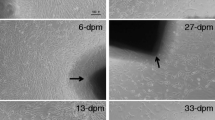Abstract
Frozen animal tissues are thought to be appropriate for use as a donor for somatic cell nuclear transfer. This makes the freezing for long term storage a valuable tool for breeders needing to protect an animal population that is endangered by sanitary problems or for cryobanking of genetic resources. We report the successful cryopreservation of explants of skin derived from small biopsies from rabbit ear biopsies by using a protocol that can be easily performed by usual breeders, which are not equipped with cooling devices. By optimizing the procedure, we show that small biopsies can be kept at −20°C in a physiological solution containing 10% DMSO for up to 20 days before being deeply frozen in liquid nitrogen for long-term storage. After 10 days of storage at −20°C, the rate of viability of biopsies was similar to the control one (86 and 82% respectively). After 20 days of storage at −20°C, the rate of viability was dramatically lowered (39%), but it still allows to recover a significant population of viable cells from the preserved sample. Being appropriate to places lacking specific device, such a very simple technique may contribute to facilitate genome banking policies dedicated to the management of genetic resources in wild and domestic animals.



Similar content being viewed by others
References
Acker JP, McGann LE (2003) Protective effect of intracellular ice during freezing? Cryobiology 46:197–202
Andrabi SM, Maxwell WM (2007) A review on reproductive biotechnologies for conservation of endangered mammalian species. Anim Reprod Sci 99:223–243
Chesné P, Adenot PG, Viglietta C, Baratte M, Boulanger L, Renard JP (2002) Cloned rabbits produced by nuclear transfer from adult somatic cells. Nat Biotechnol 20:366–369
Corley-Smith GE, Brandhorst BP (1999) Preservation of endangered species and populations: a role for genome banking, somatic cell cloning, and androgenesis? Mol Reprod Dev 53:363–367
De Loecker W, De Wever F, Penninckx F (1980) Metabolic changes in human skin preserved at −3 and at −196°C. Cryobiology 17:46–53
Fahrudin M, Otoi T, Suzuki T (2001) Developmental competence of bovine embryos reconstructed by the transfert of somatic cells derived from frozen tissues. J Vet Med Sci 63:1151–1154
Fahy GM (1986) The relevance of cryoprotectant “toxicity” to cryobiology. Cryobiology 23:1–13
Folch J, Cocero MJ, Chesné P, Alabart JL, Domínguez V, Cognié Y, Roche A, Fernández-Arias A, Martí JI, Sánchez P, Echegoyen E, Beckers JF, Bonastre AS, Vignon X (2009) First birth of an animal from an extinct subspecies (Capra pyrenaica pyrenaica) by cloning. Theriogenology 71:1026–1034
Holt WV, Pickard AR, Prather RS (2004) Wildlife conservation and reproductive cloning. Reproduction 127:317–324
Joly T, Renard JP, Danchin-Burge C (2005) Rabbit breeds in the French National Cryobank. Reprod Domest Anim 40:333 (abstract)
Li S, Chen X, Fang Z, Shi J, Sheng Hui Z (2006) Rabbits generated from fibroblasts through nuclear transfer. Reproduction 131:1085–1090
Loi P, Ptak G, Barboni B, Fulka J Jr, Cappai P, Clinton M (2001) Genetic rescue of an endangered mammal by cross-species nuclear transfer using post-mortem somatic cells. Nat Biotechnol 19:962–964
Mauger PE, Le Bail PY, Labbé C (2006) Cryobanking of fish somatic cells: optimizations of fin explant culture and fin cell cryopreservation. Comp Biochem Physiol B Biochem Mol Biol 144:29–37
May SR, Wainwright JF (1985) Integrated study of the structural and metabolic degeneration of skin during 4°C storage in nutrient medium. Cryobiology 22:18–24
Moritz C, Labbé C (2008) Cryopreservation of goldfish fins and optimization for field scale cryobanking. Cryobiology 56:181–188
Perry VP (1966) A review of skin preservation. Cryobiology 3:109–130
Rosenquist MD, Cram AE, Kealey GP (1988) Skin preservation at 4°C: a species comparison. Cryobiology 25:31–37
Salvetti P, Joly T, Baudot A (2006) Effect of antibiotics on thermodynamic properties of freezing media in rabbit species: a first calorimetric approach. Cryobiology 53:268–275
Silvestre MA, Saeed AM, Escriba MJ, Garcia-Ximénez F (2002) Vitrification and rapid freezing of rabbit fetal tissues and skin samples from rabbits and pigs. Theriogenology 58:69–76
Silvestre MA, Saeed AM, Cevera RP, Escriba MJ, Garcia-Ximénez F (2003) Rabbit and pig ear skin sample cryobanking: effects of storage time and temperature of the whole ear extirpated immediately after death. Theriogenology 59:1469–1477
Silvestre MA, Sanchez JP, Gomez EA (2004) Vitrification of goat, sheep, and cattle skin samples from whole ear extirpated after death and maintained at different storage times and temperatures. Cryobiology 49:221–229
The Rio Declaration on Environment and Development (1992) Agenda 21. http://habitat.igc.org/agenda21/
Vignon X, Chesné P, Le Bourhis D, Fléchon JE, Heyman Y, Renard JP (1998) Developmental potential of bovine embryos reconstructed from enucleated matured oocytes fused with cultured somatic cells. C R Acad Sci Paris 321:735–745
Villalba R, Benitez J, De No-Lowis ERioja LF, Gomez-Villagran JL (1996) Cryopreservation of human skin with propane 1, 2 diol. Cryobiology 33:525–529
Woods EJ, Benson JD, Agca Y, Critser JK (2004) Fundamental cryobiology of reproductive cells and tissues. Cryobiology 48:146–156
Acknowledgments
This work was supported by a grant from Ministère des affaires étrangères (France), by University Mouloud Mammeri of Tizi Ouzou (Algeria), and by Institut National de la Recherche Agronomique (INRA) of Jouy en Josas. The authors wish to express their appreciation to Dr Nathalie Beaujean, Renaud Fleurot, Jean-Luc Servely, Etienne Laloy, Celeste and Daniel Le Bourhis for their kind help and Hamid Madiou for all statistical analysis.
Author information
Authors and Affiliations
Corresponding author
Rights and permissions
About this article
Cite this article
Benkeddache, D., Bodinier, P., Joly, T. et al. Recovery of viable cells from rabbit skin biopsies after storage at −20°C for up to 10 days. Cell Tissue Bank 13, 479–486 (2012). https://doi.org/10.1007/s10561-011-9280-2
Received:
Accepted:
Published:
Issue Date:
DOI: https://doi.org/10.1007/s10561-011-9280-2




